
You might also like:
Visiting Machu Picchu requires strong lungs, steady legs and mighty decision-making skills.
Among the questions you must ask yourself: Trek or train? Day trip from Cusco or overnight in Aguas Calientes? Pisco sour or Inca Kola? And the latest this-one-or-that-one to ponder: morning or afternoon shift?
In an effort to protect Peru’s most popular attraction from overcrowding and degradation, the Ministry of Culture issued a raft of rules last year that aims to protect the Inca site by modifying visitation practices.
The regulations touch on many pillars of sightseeing, such as when you can visit, where you can walk and whether you can bring an umbrella.
“Machu Picchu is a great attraction, but we are worried about its sustainability,” said Sandra Doig, incoming tourism deputy director of PROMPERU, the Commission for the Promotion of Exports and Tourism of Peru. “It is being affected by too many people at the citadel at the same time.”
Tourist numbers have been creeping up over the years. Between January and July of last year, nearly 610,000 people tread on Machu Picchu.
To decongest the crowds, the government enacted several rules that it will test out and tweak through next July. For instance, visitors can no longer linger at the citadel from sunup to sundown but must choose one of two entry periods – 6am to noon or noon to 5:30pm – and depart at the stated time.
However, if they wish to visit for the whole day, they can purchase a morning and afternoon ticket for US$70 ($96) each. Meanwhile, adventurers who bought a combo ticket for Machu Picchu and Huayna Picchu mountain or Machu Picchu mountain can enter between 7am and 8am or 10am and 11am. They must complete the trek in four hours or less.
Per the resolution, tourists must be accompanied by a certified guide, who can lead no more than 16 participants. (Guests returning in the afternoon or the following day do not need an escort as long as they possess a ticket stub from their first guided visit.)
The guides and their charges must follow one of three circuits – no straying allowed. Circuit 1 is the most extensive and hardest on the quads; Circuit 3 is the easiest, though you will miss those epic panoramas. Finally, to mitigate damage, visitors are not permitted to bring umbrellas; bags larger than 15-by-13-by-8 inches; food and drinks, with the exception of bottled water; baby strollers; walking sticks or poles, unless the guest has special needs; tripods without a permit; drones; and shoes with spiky soles or sharp heels.
The rules aren’t hammered in stone. Over the next few months, Doig said officials “will be looking at the results and improving the system little by little”.
She added that one of their most pressing concerns is the congestion on the outskirts of the complex, especially at the shuttle station. The majority of visitors catch a round-trip bus from Aguas Calientes, and long lines are common.
“One of the biggest problems is outside the citadel – the queue to take the bus,” she said. “We have to improve that service.”
Of course, tourists can do their part without the government’s nudge in the ribs. Doig reminds visitors to pack out any garbage, especially water bottles, and to never deface the UNESCO World Heritage site. She also urges tourists to venture beyond Machu Picchu. Kuelap, for instance, is a nature-rich archaeological site in the north that the Chachapoyas, or Warriors of the Cloud, built in the sixth century.
“Kuelap is a mixture of what you find at Machu Picchu,” Doig said.
For even more adventure, Choquequirao is an Inca site three times the size of Machu Picchu. Officials are considering installing a cable car to help guests reach the top, but for now, the fortress is accessible only via a gruelling two-day trek from Cusco.
“It’s more hardcore because of the altitude,” she said.
But what you lose in oxygen, you gain in elevation bragging rights: Choquequirao is nearly 2000 feet higher than Machu Picchu.
Source: stuff.co.nz
